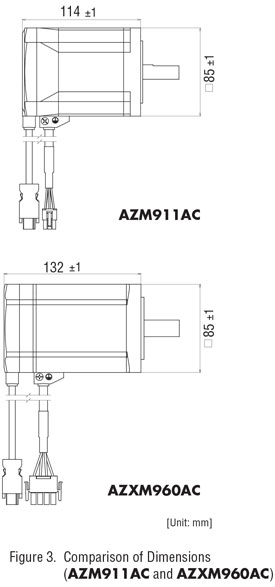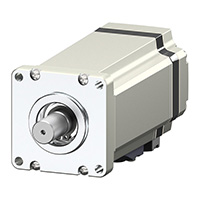Development of the AZX Series Servo Motors Equipped with ABZO Sensor
To shorten takt time, particularly for an axis that moves a large load over a long stroke, motors must deliver higher torque at high speeds. Additionally, unifying motor control is essential to minimize wiring by ensuring compatibility with various industrial networks, which in turn reduces equipment startup time.
The AZX Series was developed with the goal of achieving higher output power with the AZ Series. Higher torque in the high-speed range is achieved by replacing the hybrid stepper motor of the AZ Series with an SPM*1 motor. Furthermore, the AZX Series maintains the same level of operability as the AZ Series by incorporating its extensive functions, including the “ABZO Sensor.
This article explains the features of the AZX Series, as well as the heat separation design and heat dissipation structure change made to the motor and driver to handle increased heat generation due to higher output power.
1. Introduction
Oriental Motor has been expanding its product lineup of the AZ Series, equipped with the “ABZO Sensor” (mechanical absolute encoder), by adding multi-axis drivers and mini Driver as well as functions to support various industrial networks.
Generally, to shorten equipment takt time, higher torque motors are needed in the high-speed range for an axis of a large load in a long-stroke application. However, as the AZ Series adopts a hybrid stepper motor, the torque decreases in the high-speed range, which prevents its application to such needs.
Therefore, we have developed the AZX Series on “the concept of achieving higher output power” than the AZ Series.
The AZX Series achieves higher torque in the high-speed range by adopting a different motor from the AZ Series. This new series has the same operability as the AZ Series, adopting its ABZO sensor and extensive operation functions.

2. Features of the AZX Series
2.1. Higher Output Power with the AZ Series
The AZ Series uses a hybrid stepper motor, which provides high positioning accuracy. While the AZ Series can operate at high torque in the low-speed range, the torque is reduced in the high speed range. The AZX Series adopts the SPM motor, which is combined with the ABZO Sensor as a servo motor. This achieves higher torque in the highspeed range, as well as higher output, compared to the AZ Series. Figure 2 shows a comparison of torque characteristics between AZM911AC (AZ Series model with the highest output power) and AZXM960AC (AZX Series model), both with a frame size of 85 mm. Figure 3 shows a comparison of dimensions (AZM911AC and AZXM960AC).


The AZX Series can generate a maximum instantaneous torque, which is three times the rated torque, up to 3000 r/min, enabling acceleration up to the high-speed range in a short time. This makes shorter positioning time possible compared to the AZ Series for long-stroke positioning operations .Figure 4 shows a comparison of positioning time between AZM911AC and AZXM960AC.

2.2. Unified Operability with the AZ Series
The AZX Series unifies operability by inheriting many of the same functions as the AZ Series while achieving higher output power. This section introduces some examples.
2.2.1. Operation Functions
Equipped with the ABZO Sensor, the AZX Series is an absolute system that does not require a battery, which reduces the need for external sensors. Additionally, upon recovery from a power outage, operation can be resumed without returning to a home position. The simple sequence function, as shown in Figure 5, and the hierarchized I/O function consisting of internal I/O and interface I/O enable both faster processing by simplifying control procedure with the host controller and load reduction on the host controller(1).

2.2.2. Network Compatible
The AZX Series lineup includes an EtherNet/IPTM*2 type. Since EtherNet/IPTM is equipped as standard in most PLCs, it can be easily added by connecting a single Ethernet cable to each driver. Furthermore, as shown in Figure 6, the standardized interface and parameter IDs unified with the AZ Series via EtherNet/IPTM control help reduce equipment startup time when both series are used within the same equipment.
The AZX Series lineup also includes an EtherCAT®*3 type and a PROFINET*4 type in addition to the EtherNet/IPTM type.

2.2.3. Combining with a Rotary Table Mechanism
Like the AZ Series, the AZX Series is equipped with a convenient wrap function for rotary tables. Based on the set wrap range, the wrap function resets the number of degrees to 0 when the table rotates 360 degrees. This enables the management of position within a rotation and the wrap proximity positioning (positioning to a proximate rotational direction in a position within a rotation) even during continuous rotation in the same direction.
Oriental Motor also has a lineup of the DGII Series hollow rotary actuators for combined use with the AZX Series.
2.3. Gain Tuning
Using a servomotor requires load inertia setup, responsiveness adjustment, and resonance suppression setup.
The AZX Series can also operate with the automatic setting function even when the load inertia is unknown.
In addition, when using the MEXE02 support software, the response can be changed in real time on the gain tuning screen as shown in Figure 7. These functions together help adjust responsiveness and set up resonance suppression.
If automatic setup is insufficient, resonances can be further suppressed by identifying the resonance frequency from the FFT monitor shown in Figure 8 and setting it manually.


3. Higher Output Power
3.1. Heat Dissipation Design of the ABZO Sensor
The hybrid stepper motor used in the AZ Series has a structure with a large number of small teeth, which enables a high degree of positioning accuracy. At the same time, the higher frequency of the power supplied to the motor upon rotation generates more heat caused by iron loss, particularly during high-speed rotation. With the upper temperature limit for electronic components used in the ABZO Sensor being 85℃, the AZ Series was incapable of achieving higher speed and output. On the other hand, the AZX Series adopts the SPM motor, which reduces heat generation during high-speed operation, in addition to a design that efficiently dissipates the temperature of the ABZO sensor, both of which achieve continuous rating and higher output power at 3000 r/min.
The AZX motor integrates a heat dissipation sheet with higher thermal conductivity than air between the ABZO Sensor and the aluminum sensor cover, which efficiently conducts the heat the ABZO Sensor receives from the motor to the sensor cover, leading to excellent heat dissipation performance. The installation of the heat insulation plate between the sensor cover and the motor, which is the heat source, suppresses the temperature increase of the sensor cover and efficiently releases the heat from the ABZO Sensor. (See Figure 9.)
The thermal conductivity of each component is shown in Table 1.


This design achieves an appropriate 10℃ drop in the temperature of the ABZO Sensor at rated operation and higher speed and higher output power of the motor. (See Figure 10.)

3.2. Heat Dissipation Design of the Driver
Higher output power also increases heat generation in power devices, including the driver’s inverter circuit. Having the same heat dissipation structure as the AZ driver will cause heat to transfer to the entire driver, leading to the control devices that are sensitive to heat being exposed to temperatures higher than their temperature rating.
The AZX driver has the power devices installed on the rear side and the control devices on the front side. The forced ventilation cooling by a built-in fan works on the heat sink where the power devices are installed. The heat transferred to the heat sink is then released to the top side from the bottom side, preventing the heat generated by power devices from conducting to the control devices. (See Figure 11.)

Figure 12 shows the temperature distribution with different outputs. The driver’s power devices are implemented on the rear side, where the temperature rises as the output increases. On the other hand, the temperature at the front side where the control devices are implemented is mostly unaffected by the increased output power.

As shown above, the AZX Series has an improved heat dissipation structure that reduces the temperature effect on the heat-sensitive control devices and ensures the same maximum operating ambient temperature of 55 ℃ as the AZ Series even with increased output.
The maximum ambient temperature with closely installed drivers was 40 ℃ for the AZ Series, but the specifications have been improved to 45 ℃ for the AZX Series. (for three-phase 200 VAC input).
4. Summary
The AZX Series is developed on the concept of achieving higher output power than the AZ Series.
By changing the motor to an SPM motor―the same as servo motors and brushless motors―from a hybrid stepper motor, higher torque is produced in the high-speed range, enabling applications that are not covered by the conventional AZ Series.
The AZX Series is applicable to the same use environment as the AZ Series, thanks to the changes made to the motor and driver regarding the thermal separation design and heat dissipation structure in order to handle increased heat generation due to higher output.
The adoption of the ABZO Sensor and many other AZ Series features, such as the simple sequence function, contribute to provide the same usability as the AZ Series while reducing the time taken for equipment startup when using the AZX Series and the AZ Series in the same equipment.
Oriental Motor will continue to work toward providing products that are suitable for customers’ equipment.
